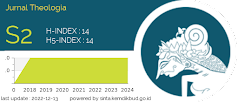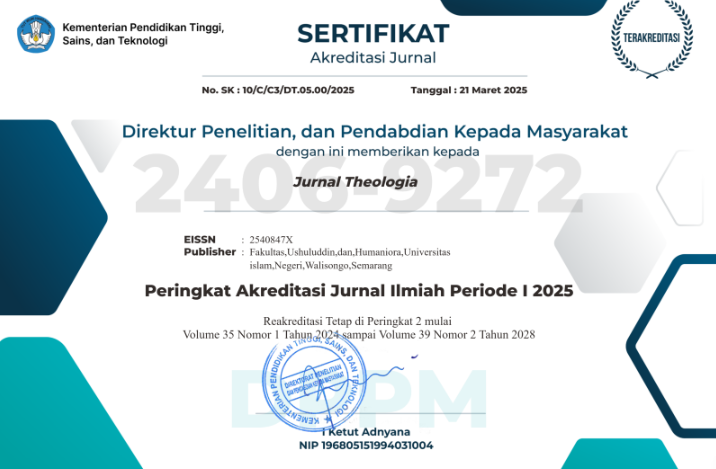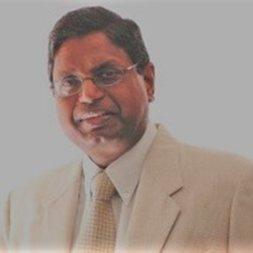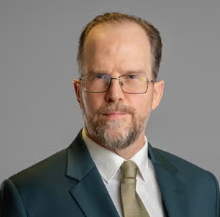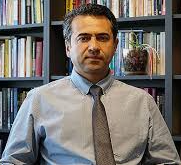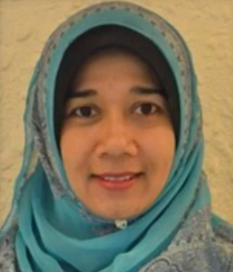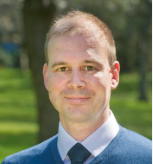ANALISIS IMPLEMENTASI PARADIGMA INTEGRASI ILMU PENGETAHUAN DI PERGURUAN TINGGI KEAGAMAAN ISLAM
(Kajian Terhadap Karya Akademik Mahasiswa di UIN Walisongo)
DOI:
https://doi.org/10.21580/teo.2019.30.2.25455Keywords:
Unity of Sciences, Islamic studies, UIN Walisongo, Scientific ParadigmAbstract
The change from the State Islamic Institute (IAIN) Walisongo to the State Islamic University (UIN) Walisongo has influenced the scientific paradigm. The scientific fields taught and developed by UIN Walisongo are increasingly diverse so that a new paradigm is needed, which is reflected in the vision of UIN Walisongo, namely ‘Leading Islamic Research University Based on the Unity of Science for Humanity and Civilisation in 2038’. The consequence of the vision requires all stakeholders at UIN Walisongo to be involved in realising it, so the understanding of UIN Walisongo's vision must be lived by the entire academic community, including students. This study aims to determine the extent to which students of UIN Walisongo understand the vision of UIN Walisongo. This research is a qualitative research with an interview and field study approach. The results of this study indicate that students of UIN Walisongo understand the vision with the following details: 60% of students use the strategy of local wisdom, 30% of students use the strategy of humanisation of Islamic sciences, and 10% of students use the strategy of spiritualisation of general sciences.
Downloads
References
Abdullah, Amin. Studi Agama: Normativitas atau Historisitas. Yogyakarta: Pustaka Pelajar. 1996.
Alexander, Denis. Rebuilding the Matrix: Science and Faith in the 21st Century. Lion, 2001.
Al-Farabi. Ihsa’ al-’Ulum. Beirut: Dar wa Maktabah al-Hilal, 1996.
Anees, Munawar. “What Islamic Science Is Not: A Rejoinder.” MAAS Journal of Islamic Science 2, no. 1 (1986).
Arif, Mahmud. Pendidikan Islam Transformatif. Yogyakarta: PT LKiS Pelangi Aksara, 2008.
Bagir, Zainal Abidin. “Bagaimana Mengintegrasikan Ilmu dan Agama?” dalam. Integrasi Ilmu dan Agama. Bandung: Mizan, 2005.
_______________________. “Sains Dan Islam dan Upaya Perluasan Panggung Sains dan Agama.’” Dalam Dunia, Manusia Dan Tuhan. Yogyakarta: Kanisius, 2008.
Barbour, Ian G. Religion and Science. New York: Harper SanFrancisco. 1990.
____________. When Science Meets Religion. New York: Harper SanFrancisco. 2000.
____________. Juru bicara Tuhan Antara Sains dan Agama. Bandung: Pustaka Mizan, 2002.
____________. Menemukan Tuhan dalam Sains Kontemporer dan Agama. Bandung: Mizan Pustaka, 2005.
Bakar, Osman. Hierarki ilmu: membangun rangka-pikir Islamisasi ilmu menurut al-Farabi, al-Ghazali, Quthb al-Din al-Syirazi. Bandung: Mizan, 1998.
_______________. Tauhid & Sains: Esai-esai tentang Sejarah dan Filsafat Sains Islam. Bandung: Pustaka Hidayah, 1995.
Data Bagian Akademik Fakultas Ushuluddin dan Humaniora UIN Walisongo, Tahun Akademik 2015-2016 dan 2016-2017.
Dawkins, Richard. “The Thinking Underlying the New Scientific Worldviews”. Dalam Russel, Robert John et al.eds., Evolutionary and Molecular Biology. USA: The University of Notre Dame Press. 1996.
Fanani, Muhyar. Aplikasi Paradigma Kesatuan Ilmu dalam Ushul Fiqh. Semarang: LP2M UIN Walisongo. 2015
_______________. Paradigma Kesatuan Ilmu Pengetahuan. Semarang: Karya Abadi Jaya. 2015.
Guessoum, Nidhal. Islam dan Sains Modern. Bandung: Mizan Pustaka, 2014.
Guiderdoni, Bruno. Membaca Alam Membaca Ayat. Bandung: Mizan Pustaka, 2004.
Gulshanī, Mahdī. Melacak Jejak Tuhan dalam Sains: Tafsir Islami atas Sains. Bandung: Mizan Pustaka, 2004.
Hamid M., Al-Naymi. Al-Kaun Wa Asraruh Fi Ayat Al-Quran Al-Karim. Aman: Al-Maktabah al-Ra’id al-Ilmiyah, 2000.
Haught, John F. Perjumpaan Sains Dan Agama: Dari Konflik Ke Dialog. Bandung: Mizan Pustaka, 2004.
______________. The Cosmic Adventure: Science, Religion and the Quest for Purpose. New York/Ramsey: Paulist Press. 1984.
______________. “Seeing the Universe: Ian Barbour and Teilhard de Chardin.” In Russel, Robert John ed. Fifty Years in Science and Religion. England: Asghate. 2004.
______________. Deeper Than Darwin: The Prospect for Religion in the Age of Evolution. USA: Westview Press. 2003.
______________. Science and Religion: From Conflict to Conversation. New York: Paulist Press. 2000.
______________. Science and Religion: In Search of Cosmic Purpose. New York: Paulist Press. 1995.
Hoodbhoy, Pervez. Islam and Science: Religious Orthodoxy and the Battle for Rationality. Zed Books, 1991.
Komarudin. Metodologi Kajian Tasawuf Berbasis Kesatuan Ilmu (Konsepsi Dosen-Dosen Pengampu Mata Kuliah Akhlak Tasawuf Universitas Islam Negeri Walisongo Semarang atas Integrasi Tasawuf dan Psikologi). Semarang: LP2M UIN Walisongo. 2015.
Laporan Kegiatan Workshop Penyusunan Kurikulum Berbasis Unity of Sciences IAIN Walisongo, 2013.
Nasr, Seyyed Hossein. Islam dan Nestapa Manusia Modern. Bandung: Pustaka, 1983.
_________________________. Sains dan Peradaban di dalam Islam. Bandung: Penerbit Pustaka, 1986.
_________________________. Tiga Mazhab Utama Filsafat Islam: Ibnu Sina, Suhrawari & Ibnu Arabi. Yogyakarta: IRCiSoD, 2014.
Rahman, Fazlur. Islam and Modernity. New York: Chicago Press. 1996
___________________. “Science and Religion”, in Science and Religion in Post-Colonial World. Australia: ATF Press. 2005.
Sardar, Ziauddin. Explorations in Islamic Science. Mansell Pub., 1989.
____________. Jihad intelektual: merumuskan parameter-parameter sains Islam. Surabaya: Risalah Gusti, 1998.
_____________. “Muslim and Philosophy of Science.” The Routledge of Islamic Phylosophy. Routledge, 1997.
Sarton, George. Introduction to the History of Science ... Vol. 1. Carnegie Institution of Washington, 1947.
Schuon, Frithjof. Dimensions of Islam. Translated by P. N. Townsend. London: Allen & Unwin, 1970.
Stenmark, Mikael. “A Religiously Partisan Science? Islamic and Christian Perspectives.” In Theology and Science. Vol. 3. Number 1 Maret 2005.
Supena, Ilyas. Implementasi Paradigma Unity of Sciences dalam Kurikulum UIN Walisongo (Analisis Buku Ajar Dosen-Dosen UIN Walisongo). Semarang: LP2M UIN Walisongo. 2016.
Swinburne, Richard. Is There a God?. Oxford New York: Oxford University. 1996.
Symons (eds.), John. Otto Neurath and the Unity of Science. New York: Springer. 2011.
W. Mark Richardson, Slack, Gordy ed. Faith in Science: Scientists Search for Truth. New York: Routledge. 2001.
Zuhdi, Imam. Perguruan Tinggi Islam di Indonesia: dari Realitas ke Idealitas. Surabaya: Bintang Pustaka. 2006.
Downloads
Published
How to Cite
Issue
Section
License

This work is licensed under a Creative Commons Attribution-NonCommercial-ShareAlike 4.0 International License.

